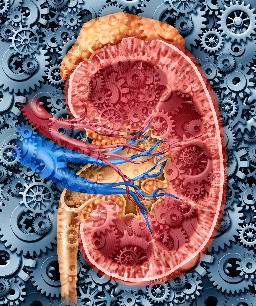Test Update: Renin and Aldosterone/Renin Ratio
 The determination of renin is useful for the investigation of secondary aldosteronism (e.g. renovascular disease, salt depletion, potassium loading, cardiac failure with ascites) or for the investigation of primary aldosteronism (adrenal adenoma/carcinoma and adrenal cortical hyperplasia). Renin can be measured as the plasma renin activity (PRA) or the direct renin concentration (DRC). Both are approved for clinical use in a recent Endocrine Society Practice Guideline, either by themselves or combined with aldosterone to obtain an aldosterone to renin ratio (1).
The determination of renin is useful for the investigation of secondary aldosteronism (e.g. renovascular disease, salt depletion, potassium loading, cardiac failure with ascites) or for the investigation of primary aldosteronism (adrenal adenoma/carcinoma and adrenal cortical hyperplasia). Renin can be measured as the plasma renin activity (PRA) or the direct renin concentration (DRC). Both are approved for clinical use in a recent Endocrine Society Practice Guideline, either by themselves or combined with aldosterone to obtain an aldosterone to renin ratio (1).
However, the sole manufacturer of the FDA approved assay kits for plasma renin activity discontinued their manufacture in December 2016. As a result, Warde Medical Laboratory validated an FDA approved kit for direct renin concentration and has converted to the methodology effective January 24, 2017.
The new assay measures the actual concentration of renin. The units are pg/mL. The old assay (Plasma Renin Activity) measured the activity of renin by measuring the production of Angiotensin 1 under controlled conditions. As an enzyme assay, it was dependent upon pH, incubation time, substrate concentration, and the presence of inhibitors or catalysts (including drugs). The units were ng/mL/hr.
There is no precise conversion factor between the two different methods. That being said, and although it varies from patient to patient, 1 ng/mL/hr of plasma renin activity approximately equals 7.6 pg/mL of direct renin concentration (range 5.5 to 9.7). So one will see higher “renin” values with the new assay.
A number of clinical studies have validated the use of the direct renin assay in screening for primary aldosteronism (2,3,4,5). In one study, at an aldosterone/ direct renin ratio of greater than 3.7 (37.0 in conventional units), the sensitivity was 90% and the specificity was 100% (2).
| The advantages of this new method are: | |
| 1 | Improved low end sensitivity. |
| 2 | Improved between lab standardization as this method is calibrated against the WHO IS 68/356 standard. |
| 3 | Less sample required. |
| 4 | Less interference from hemolysis. With the plasma renin activity assay, any hemolysis was unacceptable, but mild to moderate hemolysis is acceptable with the new direct renin assay. |
| 5 | When used with aldosterone to screen for primary aldosteronism, fewer false positives. (2) |
- Funder JW, Carey RM, et.al., Endocrine Society Practice Guideline, JCEM, (2016) 101 (5): 1889-1916.
- Lonati 6, Bassani N,et.al., Measurement of plasma renin concentration instead of plasma renin activity decreases the positive aldosterone-to-renin ratio tests in treated patients with essential hypertension. J. Hypertens 2014 Mar,32 (3): 627-34.
- Glinick P, Wojcich J, et.al., The ratios of aldosterone/plasma renin activity (ARR) versus aldosterone/direct renin concentration (ADRR). JRAAS 2015, vol. 16 (4) 1298-1305.
- Ferrar P, Shaw SG, et. al., Acive renin versus plasma renin activity to define aldosterone-to-renin ratio for primary aldosteronism. Journal of Hypertension 2004, vol. 22 No.2.
- Rossi GP, Barisa M, et. al., The aldosterone-renin-ratio based on the plasma renin activity and the direct renin assay for diagnosing aldosterone- producing adenoma. J. Hypertens 2010 Sep; 28 (9): 1892-9.

